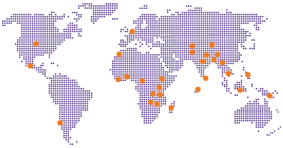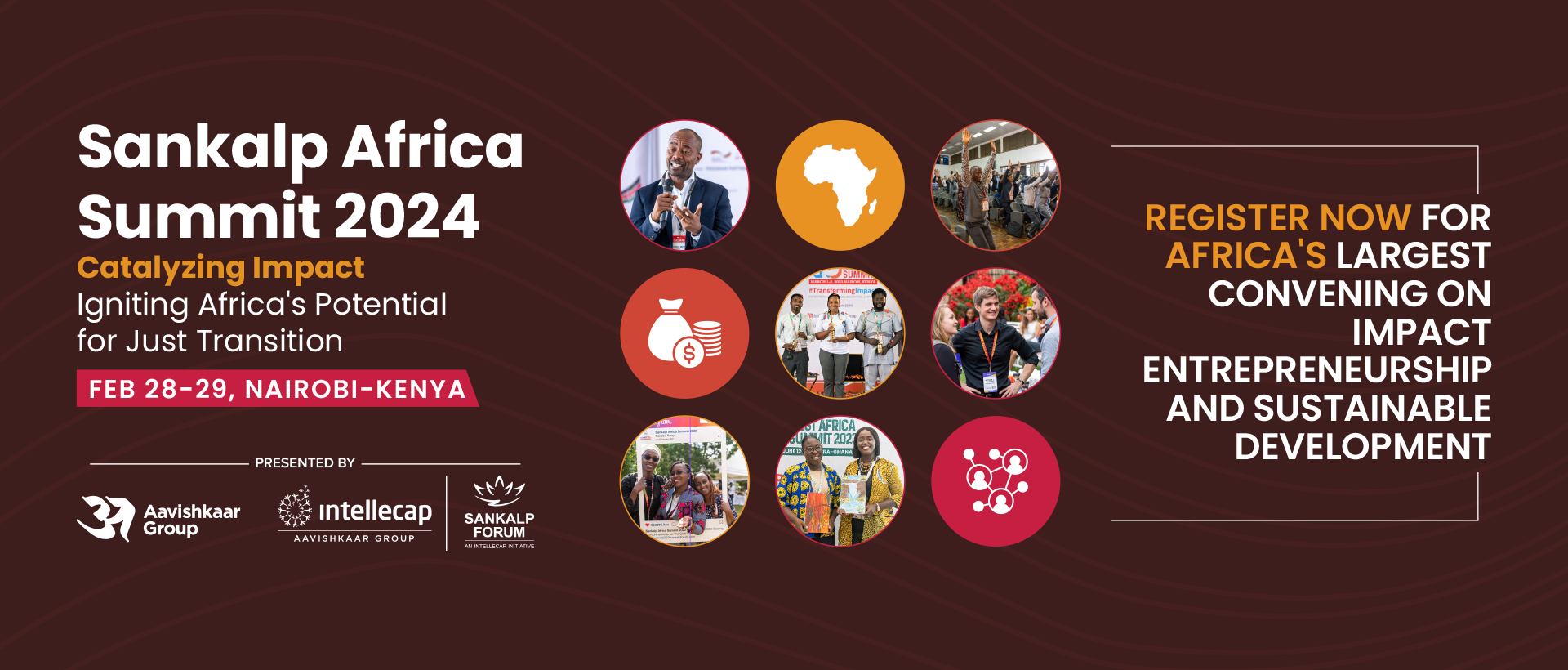-
Business Today
| July, 15, 2019World Bank Group’s Agri Insuretech Challenge Awards Nine Entrepreneurs for Innovative Agriculture Solutions (Business Today)
Read More -
Ptinews
| July, 15, 2019World Bank Group’s Agri Insuretech Challenge Awards Nine Entrepreneurs for Innovative Agriculture Solutions (Ptinews)
Read More -
The Week
| July, 15, 2019World Bank Group’s Agri Insuretech Challenge Awards Nine Entrepreneurs for Innovative Agriculture Solutions (The Week)
Read More -
WEB INDIA 123
| July, 02, 2019Sustainable Fashion Ecosystem in India Gets a Boost as Netherland-based Fashion for Good Launches its Asia Programme in Partnership With Intellecap (WEB INDIA 123)
Read More -
IANS
| July, 02, 2019Sustainable Fashion Ecosystem in India Gets a Boost as Netherland-based Fashion for Good Launches its Asia Programme in Partnership With Intellecap (IANS)
Read More -
The Week
| July, 02, 2019Sustainable Fashion Ecosystem in India Gets a Boost as Netherland-based Fashion for Good Launches its Asia Programme in Partnership With Intellecap (The Week)
Read More -
Business Today
| July, 02, 2019Sustainable Fashion Ecosystem in India Gets a Boost as Netherland-based Fashion for Good Launches its Asia Programme in Partnership With Intellecap (Business Today)
Read More -
Business Standard
| July, 02, 2019Sustainable Fashion Ecosystem in India Gets a Boost as Netherland-based Fashion for Good Launches its Asia Programme in Partnership With Intellecap (Business Standard)
Read More -
Forbes India
| July, 01, 2019Is the Indian textile and apparel industry reinventing itself ? Intellecap’s CAIF team writes for Forbes India
Read More -
Your Story
| June, 12, 2019Disha Medical Services closed USD 4 Mn round from Insitor and other HNIs
Read More

World Bank Group’s Agri Insuretech Challenge Awards Nine Entrepreneurs for Innovative Agriculture Solutions (Business Today)
World Bank Group’s flagship program, Global Index Insurance Facility (GIIF), facilitates access to finance and insurance solutions for smallholder farmers.
Supports and enables farmers to access finance and build resilience against future farm risks
MUMBAI, July 13, 2019 /PRNewswire/ — World Bank Group, through the Global Index Insurance Facility (GIIF) and Sankalp Forum by Intellecap, announced the winners of Agriculture Insuretech Innovation Challenge at the Agri Insuretech Forum that took place at the Taj Mahal Hotel in Mumbai, today.
The event witnessed participation from leading insurance companies, government officials from Ministry of Agriculture, impact investors, and innovators incubators from the agriculture, technology, and insurance sectors. The platform held key panel discussions on bringing together the agri-insuretech ecosystem stakeholders such as innovators, investors, government, academia, technology and financial services companies to deliberate on the role that technology innovations can play in driving the design, distribution and adoption of agricultural insurance solutions. Key government dignitaries Suhas Divase, Commissioner of Agriculture, Government of Maharashtra and Dr. Ashish Kumar Bhutani, CEO, Pradhan Mantri Fasal Bima Yojana, Government of India were also part of the panel discussions.
Speaking about the strategic partnership, Vikas Bali, CEO, Intellecap Advisory Services, said, “The partnership between GIIF and Intellecap comes at a very important time. Solving agri and smallholder farmer incomes is key to making a more equitable and sustainable ecosystem. Through this partnership, we have brought together innovators from 21 countries who will drive this change. This summit is just a start of a long eventful journey.”
Of the world’s 500 million smallholder farmers, around 400 million are in Asia. The region is home to some of the world’s most climate-exposed territories and has been disproportionately hit by the effects of climate change, with 45 percent of the world’s natural disasters occurring here in the past three decades. Smallholders farmers, in particular, are suffering from crop failures that can threaten their economic livelihood. The Global Index Insurance Facility (GIIF), is supporting farmers and micro-entrepreneurs in developing countries to gain better access to finance and manage financial losses arising from frequent and severe weather events.
Fatou Assah, GIIF Program Manager, World Bank Group, said, “The World Bank Group is committed to promoting agriculture insurance for smallholder farmers, so they can protect themselves against more frequent and severe climate events. The adoption of Insuretech solutions helps reach the larger number of low-income rural populations with financial products that are needed, cost-effective, transparent, and simple. I am delighted that the innovators participating in this challenge are contributing to the betterment of the rural finance ecosystem with scalable technology solutions that can be replicated in other geographies.”
The event was closed with the announcement of the Agri Insuretech Challenge winners. The Awards recognized some of South and Southeast Asia’s most promising entrepreneurs who are using technology to address challenges in providing agricultural insurance to farmers. The awards were given under three categories of an insurance product’s lifecycle — Data & Analytics, Sales and Distribution, and Premiums & Claims. The 9 winners, selected from 24 challenge finalists and 105 applicants, won cash awards valued at $270,000. They will now collaborate with WBG’s Global Index Insurance Facility to develop their solutions further to improve agricultural insurance products and their uptake, particularly in the Asia Pacific region. The nine winners are:
Data & Analytics:
Stellaps
MoooFarm
Niruthi
Sales & Distribution:
ICT 4 Agri
Hara
HF Mlog
Premiums & Claims:
Gramcover
Coastal
Dhwani RIS
Keynote speaker, Vineet Rai, CEO of leading impact investment group, Aavishkaar Capital said, “There is a huge opportunity for entrepreneurs if they look at different verticals in the agriculture value chain and create specialization. Capital should not be an issue as there is serious interest in agri tech from the investor community.”

World Bank Group’s Agri Insuretech Challenge Awards Nine Entrepreneurs for Innovative Agriculture Solutions (Ptinews)
World Bank Group’s flagship program, Global Index Insurance Facility (GIIF), facilitates access to finance and insurance solutions for smallholder farmers.
Supports and enables farmers to access finance and build resilience against future farm risks
MUMBAI, July 13, 2019 /PRNewswire/ — World Bank Group, through the Global Index Insurance Facility (GIIF) and Sankalp Forum by Intellecap, announced the winners of Agriculture Insuretech Innovation Challenge at the Agri Insuretech Forum that took place at the Taj Mahal Hotel in Mumbai, today.
The event witnessed participation from leading insurance companies, government officials from Ministry of Agriculture, impact investors, and innovators incubators from the agriculture, technology, and insurance sectors. The platform held key panel discussions on bringing together the agri-insuretech ecosystem stakeholders such as innovators, investors, government, academia, technology and financial services companies to deliberate on the role that technology innovations can play in driving the design, distribution and adoption of agricultural insurance solutions. Key government dignitaries Suhas Divase, Commissioner of Agriculture, Government of Maharashtra and Dr. Ashish Kumar Bhutani, CEO, Pradhan Mantri Fasal Bima Yojana, Government of India were also part of the panel discussions.
Speaking about the strategic partnership, Vikas Bali, CEO, Intellecap Advisory Services, said, “The partnership between GIIF and Intellecap comes at a very important time. Solving agri and smallholder farmer incomes is key to making a more equitable and sustainable ecosystem. Through this partnership, we have brought together innovators from 21 countries who will drive this change. This summit is just a start of a long eventful journey.”
Of the world’s 500 million smallholder farmers, around 400 million are in Asia. The region is home to some of the world’s most climate-exposed territories and has been disproportionately hit by the effects of climate change, with 45 percent of the world’s natural disasters occurring here in the past three decades. Smallholders farmers, in particular, are suffering from crop failures that can threaten their economic livelihood. The Global Index Insurance Facility (GIIF), is supporting farmers and micro-entrepreneurs in developing countries to gain better access to finance and manage financial losses arising from frequent and severe weather events.
Fatou Assah, GIIF Program Manager, World Bank Group, said, “The World Bank Group is committed to promoting agriculture insurance for smallholder farmers, so they can protect themselves against more frequent and severe climate events. The adoption of Insuretech solutions helps reach the larger number of low-income rural populations with financial products that are needed, cost-effective, transparent, and simple. I am delighted that the innovators participating in this challenge are contributing to the betterment of the rural finance ecosystem with scalable technology solutions that can be replicated in other geographies.”
The event was closed with the announcement of the Agri Insuretech Challenge winners. The Awards recognized some of South and Southeast Asia’s most promising entrepreneurs who are using technology to address challenges in providing agricultural insurance to farmers. The awards were given under three categories of an insurance product’s lifecycle — Data & Analytics, Sales and Distribution, and Premiums & Claims. The 9 winners, selected from 24 challenge finalists and 105 applicants, won cash awards valued at $270,000. They will now collaborate with WBG’s Global Index Insurance Facility to develop their solutions further to improve agricultural insurance products and their uptake, particularly in the Asia Pacific region. The nine winners are:
Data & Analytics:
– Stellaps
– MoooFarm
– Niruthi
Sales & Distribution:
– ICT 4 Agri
– Hara
– HF Mlog
Premiums & Claims:
– Gramcover
– Coastal
– Dhwani RIS
Keynote speaker, Vineet Rai, CEO of leading impact investment group, Aavishkaar Capital said, “There is a huge opportunity for entrepreneurs if they look at different verticals in the agriculture value chain and create specialization. Capital should not be an issue as there is serious interest in agri tech from the investor community.”

World Bank Group’s Agri Insuretech Challenge Awards Nine Entrepreneurs for Innovative Agriculture Solutions (The Week)
(Eds: Disclaimer: The following press release comes to you under an arrangement with PR Newswire. PTI takes no editorial responsibility for the same.)
World Bank Group’s flagship program, Global Index Insurance Facility (GIIF), facilitates access to finance and insurance solutions for smallholder farmers.
Supports and enables farmers to access finance and build resilience against future farm risks
MUMBAI, July 13, 2019 /PRNewswire/ — World Bank Group, through the Global Index Insurance Facility (GIIF) and Sankalp Forum by Intellecap, announced the winners of Agriculture Insuretech Innovation Challenge at the Agri Insuretech Forum that took place at the Taj Mahal Hotel in Mumbai, today.
The event witnessed participation from leading insurance companies, government officials from Ministry of Agriculture, impact investors, and innovators incubators from the agriculture, technology, and insurance sectors. The platform held key panel discussions on bringing together the agri-insuretech ecosystem stakeholders such as innovators, investors, government, academia, technology and financial services companies to deliberate on the role that technology innovations can play in driving the design, distribution and adoption of agricultural insurance solutions. Key government dignitaries Suhas Divase, Commissioner of Agriculture, Government of Maharashtra and Dr. Ashish Kumar Bhutani, CEO, Pradhan Mantri Fasal Bima Yojana, Government of India were also part of the panel discussions.
Speaking about the strategic partnership, Vikas Bali, CEO, Intellecap Advisory Services, said, “The partnership between GIIF and Intellecap comes at a very important time. Solving agri and smallholder farmer incomes is key to making a more equitable and sustainable ecosystem. Through this partnership, we have brought together innovators from 21 countries who will drive this change. This summit is just a start of a long eventful journey.”
Of the world’s 500 million smallholder farmers, around 400 million are in Asia. The region is home to some of the world’s most climate-exposed territories and has been disproportionately hit by the effects of climate change, with 45 percent of the world’s natural disasters occurring here in the past three decades. Smallholders farmers, in particular, are suffering from crop failures that can threaten their economic livelihood. The Global Index Insurance Facility (GIIF), is supporting farmers and micro-entrepreneurs in developing countries to gain better access to finance and manage financial losses arising from frequent and severe weather events.
Fatou Assah, GIIF Program Manager, World Bank Group, said, “The World Bank Group is committed to promoting agriculture insurance for smallholder farmers, so they can protect themselves against more frequent and severe climate events. The adoption of Insuretech solutions helps reach the larger number of low-income rural populations with financial products that are needed, cost-effective, transparent, and simple. I am delighted that the innovators participating in this challenge are contributing to the betterment of the rural finance ecosystem with scalable technology solutions that can be replicated in other geographies.”
The event was closed with the announcement of the Agri Insuretech Challenge winners. The Awards recognized some of South and Southeast Asia’s most promising entrepreneurs who are using technology to address challenges in providing agricultural insurance to farmers. The awards were given under three categories of an insurance product’s lifecycle — Data & Analytics, Sales and Distribution, and Premiums & Claims. The 9 winners, selected from 24 challenge finalists and 105 applicants, won cash awards valued at $270,000. They will now collaborate with WBG’s Global Index Insurance Facility to develop their solutions further to improve agricultural insurance products and their uptake, particularly in the Asia Pacific region. The nine winners are:
Data & Analytics:
– Stellaps
– MoooFarm
– Niruthi
Sales & Distribution:
– ICT 4 Agri
– Hara
– HF Mlog
Premiums & Claims:
– Gramcover
– Coastal
– Dhwani RIS
Keynote speaker, Vineet Rai, CEO of leading impact investment group, Aavishkaar Capital said, “There is a huge opportunity for entrepreneurs if they look at different verticals in the agriculture value chain and create specialization. Capital should not be an issue as there is serious interest in agri tech from the investor community.”

Sustainable Fashion Ecosystem in India Gets a Boost as Netherland-based Fashion for Good Launches its Asia Programme in Partnership With Intellecap (WEB INDIA 123)
Innovative startups from India with disruptive sustainability solutions applicable to the fashion supply chain will now have the opportunity to be part of a Asia innovation programme launched by Fashion for Good, supported by Intellecap.
India is not only a global leader in manufacturing and one of the largest consumer markets for fashion, it is also increasingly a hotspot for innovators that tap into the growing opportunities to create value and impact both socially and environmentally from a transition towards a circular economy. With a rich heritage in textile manufacturing and production, Fashion for Good, Intellecap’s Circular Apparel Innovation factory (CAIF) and its Indian corporate partners are seeking to spark and scale promising innovations from this region that have the potential to disrupt the current fashion supply chain worldwide. Of particular interest will be the unique perspective of home-grown innovators focusing in key areas including raw materials, dyeing and finishing, manufacturing, retail, end-of-use and transparency and traceability.
We are pleased to see the Fashion for Good innovation platform expanding to Asia; together we will continue to work on promoting and growing the sustainable technologies originating from the FFG platform. We are looking forward to work with these technologies to fuel next set of growth in manufacturing for us with the aim of growing with drastically less environmental impact,” said Punit Lalbhai, Board of Directors; Arvind Limited.
“Our team at Intellecap is very excited to work with Fashion for Good to scale up sustainable fashion innovations in India. Our organizations share a similar vision of putting entrepreneurship in the center of change, and by joining forces, we believe we can build a powerful ecosystem to nurture and grow high impact innovations that are needed to bring India’s fashion industry on a more sustainable growth path,” said Stefanie Bauer, CAIF Intellecap.
Fashion for Good is working on scaling innovations in the region, by catalysing collaborative pilots, which address areas such as making organic cotton traceable and solutions for the treatment of waste water from the apparel manufacturing process.
Katrin Ley, Managing Director of Fashion for Good, explains: “Working closely with these local partners enables us to promote the transition of the fashion industry towards more sustainable, circular practices as well as the betterment of social and environmental issues.”
Leading up to the programme launch, Intellecap and Fashion for Good would host a series of events across India to engage the Indian sustainable textile ecosystem. A first joint event was hosted on 25th of June in Bangalore, followed by an event in the context of this year’s Lakme Fashion Week on 23rd of August, and culminating in a investor showcase at this year’s Sankalp Forum 2019 in November 2019 in Mumbai.

Sustainable Fashion Ecosystem in India Gets a Boost as Netherland-based Fashion for Good Launches its Asia Programme in Partnership With Intellecap (IANS)
Innovative startups from India with disruptive sustainability solutions applicable to the fashion supply chain will now have the opportunity to be part of a Asia innovation programme launched by Fashion for Good, supported by Intellecap.
India is not only a global leader in manufacturing and one of the largest consumer markets for fashion, it is also increasingly a hotspot for innovators that tap into the growing opportunities to create value and impact both socially and environmentally from a transition towards a circular economy. With a rich heritage in textile manufacturing and production, Fashion for Good, Intellecap’s Circular Apparel Innovation factory (CAIF) and its Indian corporate partners are seeking to spark and scale promising innovations from this region that have the potential to disrupt the current fashion supply chain worldwide. Of particular interest will be the unique perspective of home-grown innovators focusing in key areas including raw materials, dyeing and finishing, manufacturing, retail, end-of-use and transparency and traceability.
“We are pleased to see the Fashion for Good innovation platform expanding to Asia; together we will continue to work on promoting and growing the sustainable technologies originating from the FFG platform. We are looking forward to work with these technologies to fuel next set of growth in manufacturing for us with the aim of growing with drastically less environmental impact,” said Punit Lalbhai, Board of Directors; Arvind Limited.
“Our team at Intellecap is very excited to work with Fashion for Good to scale up sustainable fashion innovations in India. Our organizations share a similar vision of putting entrepreneurship in the center of change, and by joining forces, we believe we can build a powerful ecosystem to nurture and grow high impact innovations that are needed to bring India’s fashion industry on a more sustainable growth path,” said Stefanie Bauer, CAIF Intellecap.
Fashion for Good is working on scaling innovations in the region, by catalysing collaborative pilots, which address areas such as making organic cotton traceable and solutions for the treatment of waste water from the apparel manufacturing process.
Katrin Ley, Managing Director of Fashion for Good, explains: “Working closely with these local partners enables us to promote the transition of the fashion industry towards more sustainable, circular practices as well as the betterment of social and environmental issues.”
Leading up to the programme launch, Intellecap and Fashion for Good would host a series of events across India to engage the Indian sustainable textile ecosystem. A first joint event was hosted on 25th of June in Bangalore, followed by an event in the context of this year’s Lakme Fashion Week on 23rd of August, and culminating in a investor showcase at this year’s Sankalp Forum 2019 in November 2019 in Mumbai.

Sustainable Fashion Ecosystem in India Gets a Boost as Netherland-based Fashion for Good Launches its Asia Programme in Partnership With Intellecap (The Week)
Innovative startups from India with disruptive sustainability solutions applicable to the fashion supply chain will now have the opportunity to be part of a Asia innovation programme launched by Fashion for Good, supported by Intellecap.
India is not only a global leader in manufacturing and one of the largest consumer markets for fashion, it is also increasingly a hotspot for innovators that tap into the growing opportunities to create value and impact both socially and environmentally from a transition towards a circular economy. With a rich heritage in textile manufacturing and production, Fashion for Good, Intellecap’s Circular Apparel Innovation factory (CAIF) and its Indian corporate partners are seeking to spark and scale promising innovations from this region that have the potential to disrupt the current fashion supply chain worldwide. Of particular interest will be the unique perspective of home-grown innovators focusing in key areas including raw materials, dyeing and finishing, manufacturing, retail, end-of-use and transparency and traceability.
“We are pleased to see the Fashion for Good innovation platform expanding to Asia; together we will continue to work on promoting and growing the sustainable technologies originating from the FFG platform. We are looking forward to work with these technologies to fuel next set of growth in manufacturing for us with the aim of growing with drastically less environmental impact,” said Punit Lalbhai, Board of Directors; Arvind Limited.
“Our team at Intellecap is very excited to work with Fashion for Good to scale up sustainable fashion innovations in India. Our organizations share a similar vision of putting entrepreneurship in the center of change, and by joining forces, we believe we can build a powerful ecosystem to nurture and grow high impact innovations that are needed to bring India’s fashion industry on a more sustainable growth path,” said Stefanie Bauer, CAIF Intellecap.
Fashion for Good is working on scaling innovations in the region, by catalysing collaborative pilots, which address areas such as making organic cotton traceable and solutions for the treatment of waste water from the apparel manufacturing process.
Katrin Ley, Managing Director of Fashion for Good, explains: “Working closely with these local partners enables us to promote the transition of the fashion industry towards more sustainable, circular practices as well as the betterment of social and environmental issues.”
Leading up to the programme launch, Intellecap and Fashion for Good would host a series of events across India to engage the Indian sustainable textile ecosystem. A first joint event was hosted on 25th of June in Bangalore, followed by an event in the context of this year’s Lakme Fashion Week on 23rd of August, and culminating in a investor showcase at this year’s Sankalp Forum 2019 in November 2019 in Mumbai.
Eligible Innovators can apply to the Programme here: LINK
About Fashion for Good
Fashion for Good is the global initiative that is here to make all fashion good. It’s a global platform for innovation, made possible through collaboration and community. With an open invitation to the entire apparel industry, Fashion for Good convenes brands, producers, retailers, suppliers, non-profit organisations, innovators and funders united in their shared ambition.
At the core of Fashion for Good is our innovation platform. Through our Fashion for Good Accelerator Programme we give promising start-up innovators the expertise and access to funding they need in order to grow. Our Scaling Programme supports innovations that have passed the proof-of-concept phase, with a dedicated team that offers bespoke support and access to expertise, customers and capital. Our Good Fashion Fund will catalyse access to finance to shift at scale to more sustainable production methods.
Fashion for Good also acts as a convener for change. In October 2018, the Fashion for Good Experience has opened the world’s first interactive tech museum dedicated to sustainable fashion innovation. In its hub in Amsterdam, Fashion for Good also houses a Circular Apparel Community co-working space, creates open-source resources like its Good Fashion Guide about circular apparel.
Fashion for Good’s programmes are supported by founding partner C&A Foundation and corporate partners adidas, C&A, BESTSELLER, Galeries Lafayette Group, Kering, Otto Group, PVH Corp., Stella McCartney, Target and Zalando and affiliate partners Arvind and Nørrona.
About Circular Apparel Innovation Factory (CAIF):
Intellecap, supported by the DOEN Foundation, launched the Circular Apparel Innovation Factory (CAIF) in 2018. CAIF is an initiative that brings together a variety of stakeholders in the apparel industry in India to shift the industry from its current ‘take-make-dispose’ approach, to one that is more circular across the lifecycle. CAIF’s is an industry-led platform aiming to build a circular apparel and textile industry. Our mission is to build capabilities and the ecosystem needed for a transition towards a circular textile and apparel industry in South Asia. We leverage the Aavishkaar approach of creating impact at scale through providing access to capital, knowledge, and networks throughout the journey of a circular innovation.

Sustainable Fashion Ecosystem in India Gets a Boost as Netherland-based Fashion for Good Launches its Asia Programme in Partnership With Intellecap (Business Today)
Innovative startups from India with disruptive sustainability solutions applicable to the fashion supply chain will now have the opportunity to be part of a Asia innovation programme launched by Fashion for Good, supported by Intellecap.
India is not only a global leader in manufacturing and one of the largest consumer markets for fashion, it is also increasingly a hotspot for innovators that tap into the growing opportunities to create value and impact both socially and environmentally from a transition towards a circular economy. With a rich heritage in textile manufacturing and production, Fashion for Good, Intellecap’s Circular Apparel Innovation factory (CAIF) and its Indian corporate partners are seeking to spark and scale promising innovations from this region that have the potential to disrupt the current fashion supply chain worldwide. Of particular interest will be the unique perspective of home-grown innovators focusing in key areas including raw materials, dyeing and finishing, manufacturing, retail, end-of-use and transparency and traceability.
“We are pleased to see the Fashion for Good innovation platform expanding to Asia; together we will continue to work on promoting and growing the sustainable technologies originating from the FFG platform. We are looking forward to work with these technologies to fuel next set of growth in manufacturing for us with the aim of growing with drastically less environmental impact,” said Punit Lalbhai, Board of Directors; Arvind Limited.
“Our team at Intellecap is very excited to work with Fashion for Good to scale up sustainable fashion innovations in India. Our organizations share a similar vision of putting entrepreneurship in the center of change, and by joining forces, we believe we can build a powerful ecosystem to nurture and grow high impact innovations that are needed to bring India’s fashion industry on a more sustainable growth path,” said Stefanie Bauer, CAIF Intellecap.
Fashion for Good is working on scaling innovations in the region, by catalysing collaborative pilots, which address areas such as making organic cotton traceable and solutions for the treatment of waste water from the apparel manufacturing process.
Katrin Ley, Managing Director of Fashion for Good, explains: “Working closely with these local partners enables us to promote the transition of the fashion industry towards more sustainable, circular practices as well as the betterment of social and environmental issues.”
Leading up to the programme launch, Intellecap and Fashion for Good would host a series of events across India to engage the Indian sustainable textile ecosystem. A first joint event was hosted on 25th of June in Bangalore, followed by an event in the context of this year’s Lakme Fashion Week on 23rd of August, and culminating in a investor showcase at this year’s Sankalp Forum 2019 in November 2019 in Mumbai.
Eligible Innovators can apply to the Programme here: LINK
About Fashion for Good
Fashion for Good is the global initiative that is here to make all fashion good. It’s a global platform for innovation, made possible through collaboration and community. With an open invitation to the entire apparel industry, Fashion for Good convenes brands, producers, retailers, suppliers, non-profit organisations, innovators and funders united in their shared ambition.
At the core of Fashion for Good is our innovation platform. Through our Fashion for Good Accelerator Programme we give promising start-up innovators the expertise and access to funding they need in order to grow. Our Scaling Programme supports innovations that have passed the proof-of-concept phase, with a dedicated team that offers bespoke support and access to expertise, customers and capital. Our Good Fashion Fund will catalyse access to finance to shift at scale to more sustainable production methods.
Fashion for Good also acts as a convener for change. In October 2018, the Fashion for Good Experience has opened the world’s first interactive tech museum dedicated to sustainable fashion innovation. In its hub in Amsterdam, Fashion for Good also houses a Circular Apparel Community co-working space, creates open-source resources like its Good Fashion Guide about circular apparel.
Fashion for Good’s programmes are supported by founding partner C&A Foundation and corporate partners adidas, C&A, BESTSELLER, Galeries Lafayette Group, Kering, Otto Group, PVH Corp., Stella McCartney, Target and Zalando and affiliate partners Arvind and Nørrona.
About Circular Apparel Innovation Factory (CAIF):
Intellecap, supported by the DOEN Foundation, launched the Circular Apparel Innovation Factory (CAIF) in 2018. CAIF is an initiative that brings together a variety of stakeholders in the apparel industry in India to shift the industry from its current ‘take-make-dispose’ approach, to one that is more circular across the lifecycle. CAIF’s is an industry-led platform aiming to build a circular apparel and textile industry. Our mission is to build capabilities and the ecosystem needed for a transition towards a circular textile and apparel industry in South Asia. We leverage the Aavishkaar approach of creating impact at scale through providing access to capital, knowledge, and networks throughout the journey of a circular innovation.

Sustainable Fashion Ecosystem in India Gets a Boost as Netherland-based Fashion for Good Launches its Asia Programme in Partnership With Intellecap (Business Standard)
Innovative startups from India with disruptive sustainability solutions applicable to the fashion supply chain will now have the opportunity to be part of a Asia innovation programme launched by Fashion for Good, supported by Intellecap.
India is not only a global leader in manufacturing and one of the largest consumer markets for fashion, it is also increasingly a hotspot for innovators that tap into the growing opportunities to create value and impact both socially and environmentally from a transition towards a circular economy. With a rich heritage in textile manufacturing and production, Fashion for Good, Intellecap’s Circular Apparel Innovation factory (CAIF) and its Indian corporate partners are seeking to spark and scale promising innovations from this region that have the potential to disrupt the current fashion supply chain worldwide. Of particular interest will be the unique perspective of home-grown innovators focusing in key areas including raw materials, dyeing and finishing, manufacturing, retail, end-of-use and transparency and traceability.
“We are pleased to see the Fashion for Good innovation platform expanding to Asia; together we will continue to work on promoting and growing the sustainable technologies originating from the FFG platform. We are looking forward to work with these technologies to fuel next set of growth in manufacturing for us with the aim of growing with drastically less environmental impact,” said Punit Lalbhai, Board of Directors; Arvind Limited.
“Our team at Intellecap is very excited to work with Fashion for Good to scale up sustainable fashion innovations in India. Our organizations share a similar vision of putting entrepreneurship in the center of change, and by joining forces, we believe we can build a powerful ecosystem to nurture and grow high impact innovations that are needed to bring India’s fashion industry on a more sustainable growth path,” said Stefanie Bauer, CAIF Intellecap.
Fashion for Good is working on scaling innovations in the region, by catalysing collaborative pilots, which address areas such as making organic cotton traceable and solutions for the treatment of waste water from the apparel manufacturing process.
Katrin Ley, Managing Director of Fashion for Good, explains: “Working closely with these local partners enables us to promote the transition of the fashion industry towards more sustainable, circular practices as well as the betterment of social and environmental issues.”
Leading up to the programme launch, Intellecap and Fashion for Good would host a series of events across India to engage the Indian sustainable textile ecosystem. A first joint event was hosted on 25th of June in Bangalore, followed by an event in the context of this year’s Lakme Fashion Week on 23rd of August, and culminating in a investor showcase at this year’s Sankalp Forum 2019 in November 2019 in Mumbai.
Eligible Innovators can apply to the Programme here:
About Fashion for Good
Fashion for Good is the global initiative that is here to make all fashion good. It’s a global platform for innovation, made possible through collaboration and community. With an open invitation to the entire apparel industry, Fashion for Good convenes brands, producers, retailers, suppliers, non-profit organisations, innovators and funders united in their shared ambition.
At the core of Fashion for Good is our innovation platform. Through our Fashion for Good Accelerator Programme we give promising start-up innovators the expertise and access to funding they need in order to grow. Our Scaling Programme supports innovations that have passed the proof-of-concept phase, with a dedicated team that offers bespoke support and access to expertise, customers and capital. Our Good Fashion Fund will catalyse access to finance to shift at scale to more sustainable production methods.
Fashion for Good also acts as a convener for change. In October 2018, the Fashion for Good Experience has opened the world’s first interactive tech museum dedicated to sustainable fashion innovation. In its hub in Amsterdam, Fashion for Good also houses a Circular Apparel Community co-working space, creates open-source resources like its Good Fashion Guide about circular apparel.
Fashion for Good’s programmes are supported by founding partner C&A Foundation and corporate partners adidas, C&A, BESTSELLER, Galeries Lafayette Group, Kering, Otto Group, PVH Corp., Stella McCartney, Target and Zalando and affiliate partners Arvind and Nrrona.
About Circular Apparel Innovation Factory (CAIF):
Intellecap, supported by the DOEN Foundation, launched the Circular Apparel Innovation Factory (CAIF) in 2018. CAIF is an initiative that brings together a variety of stakeholders in the apparel industry in India to shift the industry from its current ‘take-make-dispose’ approach, to one that is more circular across the lifecycle. CAIF’s is an industry-led platform aiming to build a circular apparel and textile industry. Our mission is to build capabilities and the ecosystem needed for a transition towards a circular textile and apparel industry in South Asia. We leverage the Aavishkaar approach of creating impact at scale through providing access to capital, knowledge, and networks throughout the journey of a circular innovation.
About Intellecap:
Intellecap is a pioneer in building enabling ecosystems and channeling capital to create and nurture a sustainable & equitable society. Founded in 2002, Intellecap works across critical sectors like Agriculture, Livelihoods, Climate Change, Clean Energy, Financial Services, Gender & Inclusion, Healthcare, Water and Sanitation, and has delivered over 500 global engagements across 40+ countries and syndicated investments of over $500 Million USD in Capital. Intellecap through its presence in India and Africa, provides a broad range of Consulting, Research and Investment Banking Services, to Multilateral Agencies, Development Finance Institutions, Social Enterprises, Corporations, Investors, Policy Makers and Donors. Our common action platform, Sankalp Forum, one of the largest global inclusive development platforms, brings together the ecosystem to shape the way markets work for delivering the SDGs 2030.
For more details, please visit, https://www.intellecap.

Is the Indian textile and apparel industry reinventing itself ? Intellecap’s CAIF team writes for Forbes India
The Aavishkaar Group’s content partnership with Forbes India, one of the most reputed business publication allows our leaders from across the Group to share their ideas, insights and expertise through this yearlong special series.
This is the seventh article as part of this partnership.
Mumbai, July 1 Monday: Stefanie Bauer , Director, Circular Apparel Innovation Factory (CAIF) Intellecap and Divya Jagasia, Senior Associate Intellecap contribute the seventh story in the Forbes series June Issue as part of our yearlong content partnership with Forbes India
As a quick recap the first story titled ‘Instant loans: Alternate data to drive next financial inclusion wave’ in this Forbes Series was authored by Atreya Rayaprolu, Co-Founder and CEO Tribe3. The second story titled ‘Smart villages: Driving development through entrepreneurship’ was coauthored by Santosh Kumar Singh, Director, Intellecap and Ankit Gupta, Manager, Intellecap. The third story titled ‘What most women-led enterprises in India have in common’ was coauthored by Urvashi Devidayal, Sankalp Lead India and Prachi Maheshwari, Gender Lead Intellecap. The fourth story titled A Roadmap for Impact Investment In India’ was authored by Vineet Rai, Founder, The Aavishkaar Group. The fifth story titled ‘Overlooked area for Impact: Last Mile connectivity was authored by Vineeth Menon, AVP, Intellecap and the sixth story titled ‘How big data can optimise the Microfinance sector’ was authored by Manoj Nambiar, MD, Arohan.
India is a global manufacturing hub for textiles and apparel, coping with growing international and domestic demand. While the global textiles market is projected to reach $1.3 trillion by 2025, the domestic market for apparel is estimated to reach $59.3 billion by 2022 and that for textiles to grow to $223 billion by 2021. Thus as an industry it presently contributes 5 percent of India’s current GDP. Titled ‘Is the Indian textile and apparel industry reinventing itself ?‘ the authors talk about how with rising awareness of fast fashion and its impact on the environment, brands and manufacturers are willing to make a shift to circularity.
The authors cite serious cause for concern with over 60 percent of Indian textiles which are cotton based, and cotton cultivation consuming 25 percent of the world’s pesticides. Therefore with rising awareness of these challenges, globally and in the Indian context, the authors talk about how brands and manufacturers are willing to make a shift to circularity.
The authors then shed light on how organisations have started experimenting and innovating towards the circular textile economy goals and how forward-looking industry players are preparing themselves for ‘self-disruption’ to build a ‘Circular Fashion Industry’ globally, which means building a fashion industry that can phase out substances of concern, increase clothing utilisation, improve recycling and efficiently use resources, according to the New Textiles Economy report by the Ellen MacArthur Foundation.
The authors also speak about how India has also become a hotbed for circular startups, who are having a significant impact, with innovations ranging from alternative materials to innovative retail models. Be it Mumbai based Boheco which is trying to reduce and replace the use of cotton in textiles with hemp fiber, or Chennai based Trustrace who are using blockchain technology to improve transparency and traceability in the supply chain or even Lionise and Kiabza who are two startups innovating with new retail models of rental and second-hand clothing respectively, it is indeed exciting times for the Industry.
The authors finally conclude by showcasing how Corporate-startup partnerships have become more commonplace as both stakeholders begin to see the benefits of collaboration and how early movers in the Indian fashion industry are already taking active steps to engage with a pool of circular innovators. They opine that while a consensus is emerging to make an impact on the circularity agenda, to do that effectively, it is essential to accelerate collaboration between corporations and startups. While enablers have access to entrepreneurs, other innovation pools are identifying and driving ‘unlikely alliances’ between the two. This is a strong indication that the textile industry is beginning to embrace the circular economy through serious intent and not just an ephemeral sentiment. The movement is set to remarkably influence and will shape the core value system of the industry over the coming years.

Disha Medical Services closed USD 4 Mn round from Insitor and other HNIs
Mumbai, 12 June 2019: Disha Medical Services (branded as ‘Drishti’), an eye care chain focused on providing affordable eye care in the underserved markets in the Southern region of India, has raised Series C funding of USD 4 Million from Insitor Impact Asia Fund, the Nilekani Family Office (managed by Entrust Family Office) and other HNIs. Exiting investor, Lok advised fund – Sarva Capital has been provided a full exit as a part of this current fund raise. Intellecap acted as the exclusive financial advisor for the transaction. Intellecap’s Investment Banking Group acted as the exclusive financial advisor for the transaction.
Drishti was founded by Anjali Joshi, Kiran Anandampillai and Dr. Rajesh Babu. Anjali and Kiran are engineers who after successful corporate careers started the healthcare chain to bring high quality of care to tier 2 towns. It currently manages 6 eye hospitals, 6 mobile eye clinics and 4 vision centers across various towns of Karnataka. The company has treated over 4.6 lakh patients across these locations. Drishti is a proud winner of the ET Startup Awards 2018 – in the Social Enterprise category.
“Patients will the biggest beneficiaries as this round will enable us to serve millions more in Karnataka with high quality eye care.” said Kiran Anandampillai, CEO, Disha Medical Services.
Drishti had raised seed funding from Sarva Capital in 2012. Subsequently, it received funding again from Sarva Capital and the Nilekani Family Office in Series A&B rounds respectively. The consistent support of Series A and B investors has been instrumental in establishing the Company’s operations since inception.
The Company will use the current round of capital to further strengthen its position in the existing region by building over 10 more hospitals, vision centres and mobile eye clinics as well look to expand strategically in other States.
“We will focus on empowering more Ophthalmologists with advanced infrastructure and processes that help them deliver high quality care in our markets.” said Anjali Joshi, Co-Founder, Disha Medical Services.
“Drishti’s high degree of focus on building a sustainable, scalable model that can provide affordable eyecare to millions of hitherto unserved patients was an extremely compelling opportunity for us. This closely aligns with Insitor’s mission of building fair, inclusive marketplaces for low-income consumers across our investments in Asia. We look forward to working closely with Anjali and Kiran to build out a world-class social enterprise in the healthcare space in the next few years.” says Abhijit Nath, Country Head, Insitor India.
The Nilekani Family Office said in a statement, “We believe in the vision of Drishti and its founders of providing affordable eyecare and continue to support the Company as it ramps up operations.”
“Lok has had a very satisfying journey with Kiran and Anjali, promoters of Drishti starting from the seed round in 2012. This company is in some ways an ideal example of a balanced venture that creates deep impact while delivering financial performance. We are happy that our exit has been to the current shareholders and an incoming investor that share the same philosophy of creating sustainable impact in the healthcare space in India” says Vishal Mehta, Co-Founder and Partner, Lok Advisory Services
“We are very delighted to be part of Disha Medical’s journey in bridging the eyecare needs of rural population in South India. Drishti has developed a unique model to deliver eye care and has a sustainable edge over other players.” says Sameer Gaud, Associate Director at Intellecap, which advised the Company exclusively on this transaction.
Reports & Policies
Our Impact Map

Sign up for our newsletter
© Copyright 2018 Intellecap Advisory Services Pvt. Ltd. - All Rights Reserved




